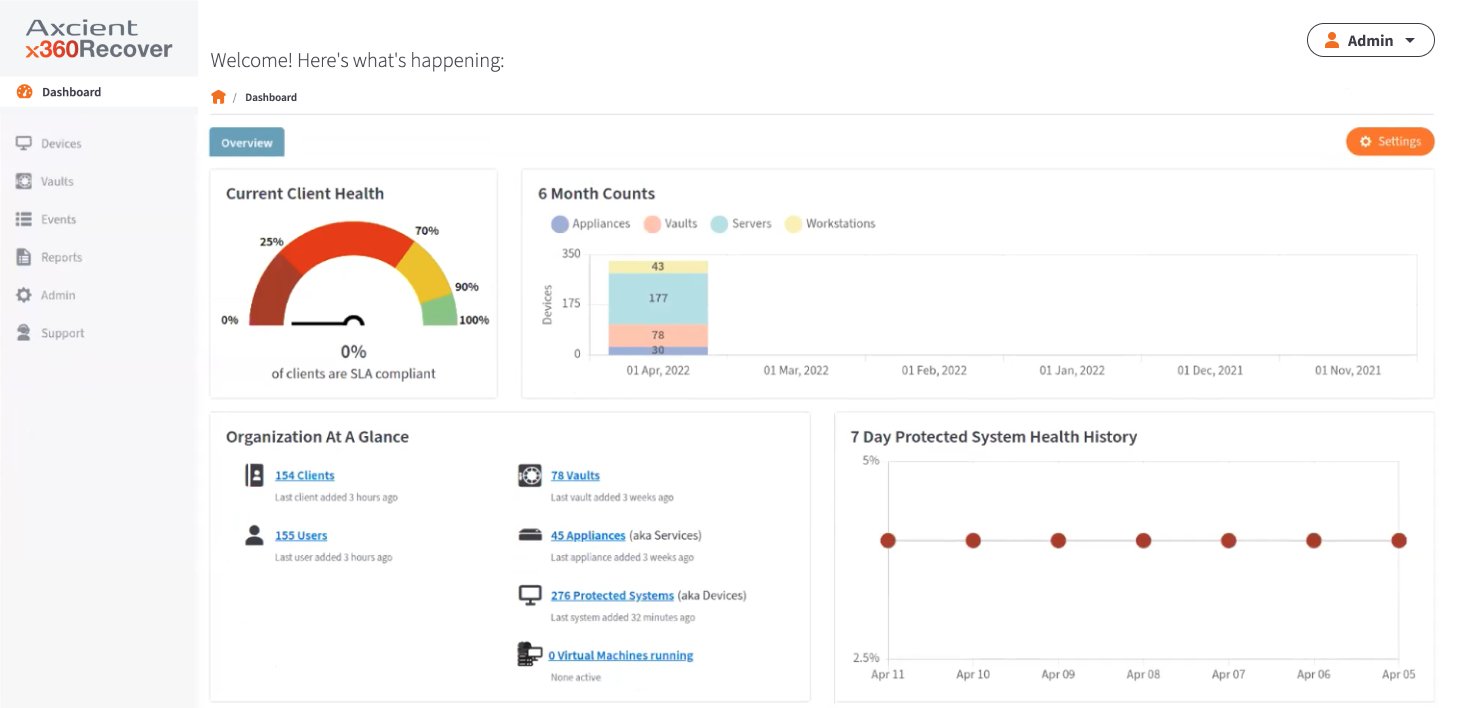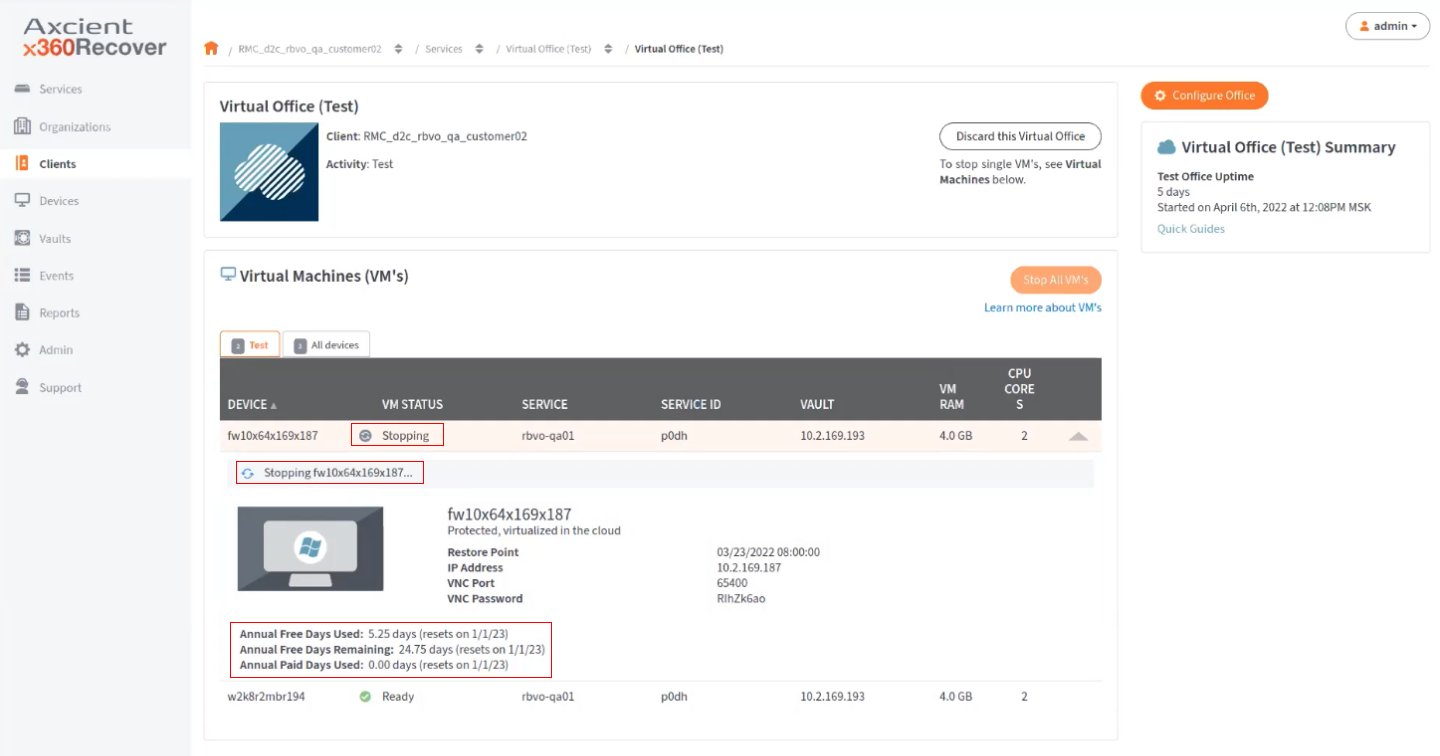
| April 2022 release notes | 2021 Release Notes |
x360Recover Manager (RMC) v 4.23 - Apr 28 2022 [Click to expand...]
Version: |
x360Recover Manager (RMC) v4.23 |
Release Date: |
April 28 2022 |
Enhancements
- Improved loading of the Organization Dashboard for large partners
- Added historical data to the 6-month device count graph on the Organization Dashboard overview for X360Recover, D2C, BRC and Fusion.
- Changed billing logic from rendered to powered state for virtual machines running in a Virtual Office for X360Recover, D2C, BRC and Fusion
Bug fixes
- Fixed a bug where values were missing on the Protected System Health History graph on the Organization Dashboard overview
- Fixed a bug where runbooks would attempt to start multiple times, and would not start successfully, for X360Recover, D2C, BRC and Fusion
Improvements to the Organization Dashboard, along with various bug fixes
x360Recover Agent 2.33 - Apr 25 2022 [Click to expand...]
x360Recover Agent Release Information | |
Agent Version: |
v.2.33 |
Release Date(s): |
Targeted release starting April 25 2022 |
Release overview
x360Recover agent 2.33 is a feature release. The primary focus of this release is to enhance x360Recover local cache with support for trimming and retention of datasets. We've also improved functionality when handling network credentials and enhanced system bootability using Smart Recovery.
Summary of enhancements
- The local cache trimming/retention cleanup feature is now enabled by default
- Replaced original Replibit Analysis Tool (RAT) with new Analysis Tool (AT)
- Local cache network credentials are now encrypted in a separate configuration file
- Local cache credential validation is now performed when managed via agent orchestration
- Added backend support for multiple file system types (The agent reports file system types to the server)
- Added support for using multiple certificate files for agent communications (to make replacement of expiring certificates easier)
- Improved performance of file scanning by directly reading MFT tables
- Optimized recovery of missing MBR dump files by allowing them to be re-sent during Incremental backups. (Previously, we required a full backup to force new dumps to be transferred)
- Added an agent configuration option to allow disabling storage hole punching for troubleshooting
- Optimized multi-threaded event handling and retries to better handle poor internet connections
- Added support for systems running Symantec Desktop Encryption
Summary of bug fixes
- Fixed cases where Smart Recovery returns RAW disks when performing AutoVerify ChkDsk tests
- Fixed case where full backup is sent after a removable volume is re-attached
- Fixed issue with mirrored dynamic disk boot volume being unbootable using Smart Recovery
- Fixed issues with invalid, failed, or missing dynamic disks in RAID mode when using Smart Recovery
- Fixed issue with GPT protected system booting to Recovery Mode when using Smart Recovery
- Fixed local cache verification when updating vaults. The updated status is sent immediately after verification completion
- Fixed issues booting if boot and/or system partitions are not on physical disk 0
- Fixed case where VM may boot to Windows Recovery mode
- Fixed issue where a volume included in the backup may be missing in Smart Recovery metadata
- Fixed issue with failure to boot Lenovo OEM system running Windows Server 2008 R2
What's new with the Analysis Tool?
- We've updated our Analysis tool (the next generation replacement for the Recover Analysis Tool (RAT). The latest version of the Analysis Tool has been completely rewritten in C++ to collect log files and configuration information about installed Axcient x360Recover components. It also collects information from system event logs, system configuration details and installed software, and can optionally upload the collected details directly to an open support ticket. This assists our support team in troubleshooting your backup related problems.
What's new with Smart Recovery?
- Smart Recovery is our next generation recovery mechanism, designed to make virtualizing and recovering your protected systems as bullet-proof as possible. Smart Recovery collects instance-specific details related to your protected system physical disks, partitions, and volumes. It then provides the platform to return exactly matching virtual disk images during a recovery. Disk signatures, volume uuid’s, even dynamic disk configurations are returned, exactly like the original protected system disks. Smart Recovery is available (a) when virtualizing a protected system, (b) during AutoVerify boot VM checks, and (c) when exporting disks via iSCSI. We recommend using the Smart Recovery mechanism whenever you are performing a recovery.
Note: Smart Recovery is not yet available when performing disk exports from a vault or appliance. If you need a virtual disk export using Smart Recovery, you can perform a virtual disk export using Recovery Center (with or without a local cache.) Recovery Center can then attach directly to an appliance for local recovery beginning with appliance version 10.18.0
What's new with local cache?
Local cache (combined with Recovery Center) is the no-hardware-BDR companion to x360Recover Direct-to-Cloud (D2C).
Local cache is an encrypted, deduplicated block store database maintained locally on-site in conjunction with your Direct-to-Cloud backup agent. This will provide you with fast, real-time recovery and virtualization of your protected systems - without the expense of a hardware backup appliance.
Local cache data can be stored on a locally-attached USB device for a single protected system. It can also be shared by one or more protected systems when stored on a network shared folder or NAS storage device.
Local cache has the following features in agent 2.33:
- Fast, efficient deduplication of data storage across one or many protected systems
- Automatic data verification and self-healing of missing blocks
- Automatic trimming of data with multiple options to specify retention settings
- Health status reporting and scoring reported to the vault
- Health status reporting visible on the Protected System Details page
Coming soon: The health status of local cache will be visible in x360Recover Manager and incorporated into the health status determination metrics for the whole protected system)
So, what does local cache do?
Local cache (if available) greatly accelerates the recovery of a Direct-to-Cloud protected system. It does this by eliminating bulky data downloads from the cloud.
The local cache repository contains all of the block data from your recent backups. It then provides that data locally - instead of over the internet - when performing a recovery.
Attaching the Recovery Center app to a local cache allows you to
- quickly perform local file and folder recovery
- export virtual disks in numerous formats
- directly virtualize a protected system on a local Hyper-V host.
For complete details on D2C local cache, see Local Cache for Direct to Cloud.
For details about local cache verification and trimming, see Local Cache Verification and Trimming for Direct to Cloud
Changes to local cache credentials and security
In Agent 2.33, local cache credentials which were previously stored in permid.cfg are now removed and stored separately in an encrypted fashion.
- You may still use permid.cfg to manually configure local cache credentials in plain text, but the credentials will be immediately removed and relocated to encrypted storage on the next agent service startup.
- Local cache credentials entered using agent orchestration from the Web UI will now be validated by the agent before being committed to the configuration file. If the local cache is not accessible using the user credentials and path provided in the Web UI, the agent configuration job will fail. Check the Jobs -> Agent page after configuring local cache from the Web UI to verify that the specified configuration was successfully applied and the local cache is accessible.
About Symantec Desktop Encryption
Recent versions of Symantec Desktop Encryption have become problematic to recover.
This is due to a new whole disk encryption obfuscation of the partition tables on disk.
With agent 2.33 and newer, the agent collects data from the running system to allow unwrapping the disk volume during recovery.
For existing systems, it is necessary to force a recapture of the underlying disk partitioning structure within a new backup. Set the following parameter in aristos.cfg to force capturing boot system dumps on the next Incremental backup:
SEND_DUMPS_NEXT=TRUE
Alternatively, you can force a new full backup scan. You can do this by navigating to the Protected System Details page, clicking Schedule Now and then selecting Full Backup.
Note: A full backup scan will be fully deduplicated and only net-new changes will be sent to the backup server, but the entire disk contents of the protected system will be scanned for changes.
|
Auto Update Best Practices We recommend that Enable Auto Update is enabled on the Settings -> Update Manager page on each of your x360Recover devices. We also recommend that you enable Auto-Enable Remote Assist When Upgrading so that remote access will be available to our development team should something go wrong with your upgrade. This will ensure that your x360Recover devices are updated with the latest software enhancements in a timely fashion, and that the x360Recover Support team will have a short window of time to access and repair any troublesome devices without requiring user intervention. |
Agent 2.33 enhances local cache with support for trimming and retention of datasets. We've also improved functionality when handling network credentials and improved system bootability using Smart Recovery.
x360Recover 10.17.0 - Apr 25 2022 [Click to expand...]
Version: |
x360Recover 10.17.0 |
Release Date: |
Apr 25 2022 |
10.17.0 provides refactoring of application internals to support the Ubuntu Bionic upgrade (occurring later this year) and eliminates forced updating during new appliance provisioning.
x360Recover Manager (RMC) v 4.22 - Apr 13 2022 [Click to expand...]
Version: |
x360Recover Manager (RMC) v4.22 |
Release Date: |
April 13 2022 |
Enhancements
- The Organization Dashboard has been redesigned. Graphs and charts now provide high-level insight on devices, and on the health of clients and systems:

- The Virtual Office details page has been updated with a new look. Visuals provide information on the current status of virtual machines and the annual free days for test VMs is clearly displayed:

- Custom alert threshold dialogs (for devices and jobs) have been redesigned for BRC, RB and D2C products to improve user experience
Bug fixes
- Fixed a bug where the Virtual Office usage report was only exporting a subset of rows
- Fixed a bug where successful backups didn’t immediately update BRC service health status
Delete
Re-designed Dashboard and Virtual Office pages provide information on the current status of virtual machines, with the annual free days for test VMs clearly displayed.
SUPPORT | 720-204-4500 | 800-352-0248
- To contact Axcient Support, please log in to the x360Portal or call 800-352-0248
- Free certification courses are available in the Axcient x360Portal under Training
- To learn more about any of our Axcient products, sign up for free one-on-one training
- Subscribe to the Axcient Status page for a list of status updates and scheduled maintenance